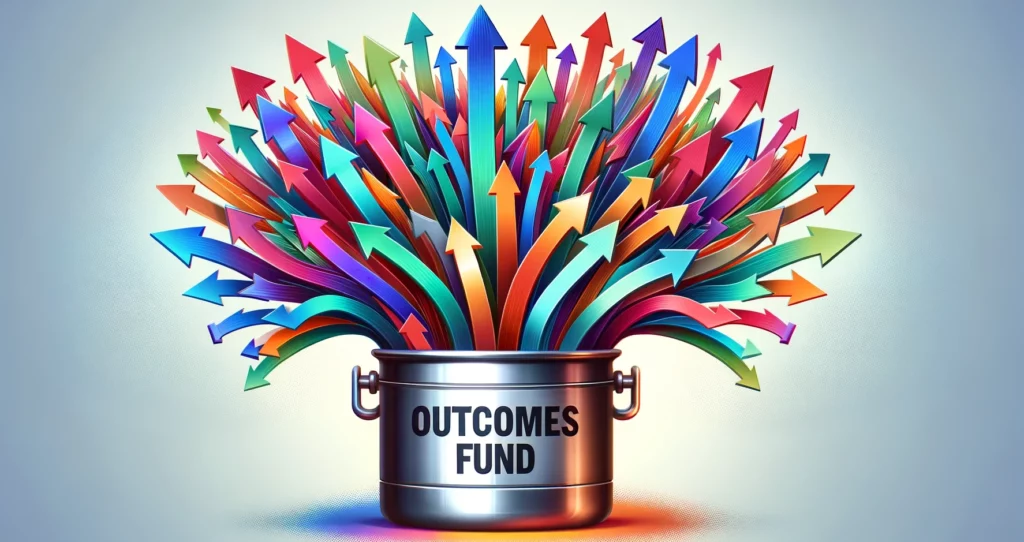Just The Basics: What Are Outcomes Funds?
Estimated reading time: 5 minutes.
Defining ‘Outcomes Funds’

Outcomes funds are pools of grant capital which are focused on achieving specific forms of ‘good’.
They adopt pay-for-success (PFS) principles to use their money most effectively.
We’ll break this topic down into some of its constituent elements.

Pay For Success
Capital
Supply
Commissioning Outcomes
How Much Money Has Been Deployed In Outcomes Funds Already?
Great work is being done to quantify the pipeline of pay for success instruments like impact bonds and outcomes funds that is primed to roll-out.
But let’s look at some data to illustrate where we are today with outcomes funds today.
These numbers come from the INDIGO project and were accurate when we imported them into our database in April of 2024:
1: Life Chances Fund (UK)
Figures based on imported data from INDIGO’s Outcomes Fund Directory (April 2024).
How Do Outcomes Funds Work?
Outcomes funds cluster together money from governments, philanthropists, and (sometimes) impact investors before disbursing it into specific projects.
In this manner, a single well-funded outcomes fund can help fund many individual projects all achieving measurable social or environmental improvements

Advantage 1: Continuity Of Capital
Continuity of capital has been a longstanding problem for many development aid and social finance projects.
Donors may provide one time gifts but then drop out of the picture.
Those working on the front lines of trying to help solve important issues may find that they have to spend most of their time and energy fundraising rather than actually helping people.
This is a frustrating situation for everyone involved.

This is why (in part) the idea of social capital wholesalers has long been advocated for and why we see them spinning up around the world.
The idea behind a social capital wholesaler is roughly what you might imagine it to be.
Rather than funding projects one-by-one, wouldn’t it make more sense if we could gather the money together and then give it out?
Such institutions already exist.
The world’s first social impact wholesaler, Better Society Capital, was created in 2012.

Advantage 2: Scaling Up Individual Social Finance Projects
There’s another reason why outcomes funds could play a very pivotal role in the impact jigsaw.
Social finance instruments like impact bonds are important because they find a way for government and (for profit) impact investors to participate in a transaction.
If we can bring private capital markets to bear on solving our social and environmental challenges, we can get much more money moving to try do good.
However, they come with a limitation:
Because they require that a few different groups come together, they’re a bit like a jigsaw puzzle that needs to be put together afresh every time.
Many think this has limited their adoption.

What Is ‘Pay For Success’?
Before looking at pay for success (PFS), let’s look at conventional government commissioning.
To distinguish it from pay for success we call this method fee for service.
When a government decides that it needs to tackle an issue (say, a rising incidence of diabetes among a specific population) it will allocate money to a delivery organisation to run a program.
If we think about what’s going on here, the government is paying for ‘inputs’
(The delivery organisation will run programs that we hope will be successful in achieving the desired outcome – in this case, a reduction in the incidence of diabetes).
So What Are ‘Outcomes,’ Then?!

Pay for outcomes proposes a different financing structure in which delivery organisations are paid in accordance with the level of ‘outcomes’ they achieve.
By breaking down what we’re trying to achieve into the unit of ‘outcomes,’ we achieve a few things.
One of them is that ‘outcomes’ can be standardised in the form of ‘tariffs’ so that aid money can be further optimised by ensuring that it targets the most in-need populations first.
In the real world, an ‘outcome’ might be that a child passes a standardised literacy test and has thus achieved literacy through an educational program (for an example of a real-life outcomes fund, see the work of the Education Outcomes Fund).

Some important things to clarify:
Firstly, outcomes “funds” aren’t “funds” in the sense that (say) an investment fund is.
They’re not profit-making although they’re managed by professionals (a small overhead needs to go to paying their salaries just as it does in the charity sector at large) ❎
Their aim is to give away the money they raise into qualifying projects ✅
Outcomes funds could be ‘one time things’.
But more ideally, they’d continue indefinitely (or at least over the long term) by periodically reraising capital every time they’ve reached their outcomes-paying capacity (ie, they’ve exhausted all the funds raised by paying for outcomes).
One of the biggest hurdles outcomes funds face is related to bureaucracy.
“Fee for service” allows governments to allocate fixed budgets for projects.
But “pay for success” necessitates that they find ways to budget for outlays that aren’t determined in advance.
Our friends at the INDIGO project at Oxford University do truly excellent work in quantifying and listing the deployment of outcomes funds globally as well as the pipeline of new outcomes funds nearing readiness.
We use their data in many of the posts about outcomes funds which can be found at this page.
Thank you for reading!